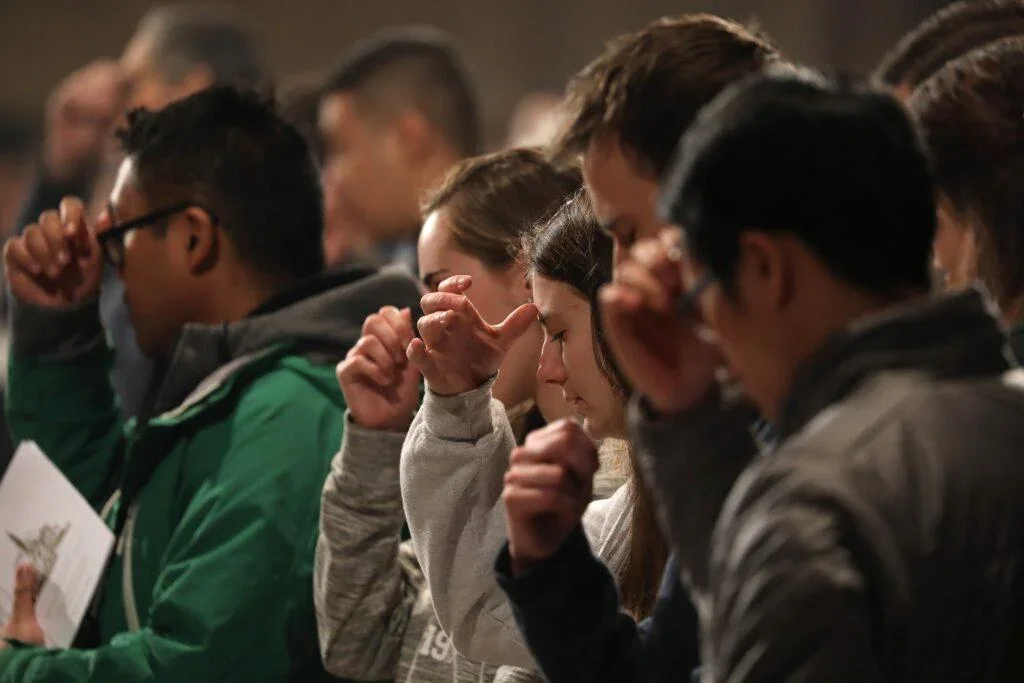“Let us not be ashamed to confess the Crucified. Let the cross be our seal, made with boldness by our fingers on our brow and on everything.” – St. Cyril of Jerusalem, Catechetical Lecture 13
The sign of the cross is not superstition, nor a meaningless gesture. It is a holy confession: a physical sign, a joyful celebration, and a faithful response to the spiritual reality of having been adopted into God’s family through Holy Baptism.
The Cross as a Sign
When we trace the cross upon ourselves, we are marking ourselves in the Name of the Father, and of the Son, and of the Holy Spirit. This action echoes back to our one baptism into the Triune God (Matt. 28:19). It proclaims that we have been given His Name, adopted into His family, forgiven of our sins, and made heirs of an everlasting inheritance.
St. Basil the Great explained: “This is taught by unwritten tradition: that those who hope in the name of our Lord Jesus Christ sign themselves with the sign of the cross.” (On the Holy Spirit, 27.66)
Each time we make this sign, we are reminding ourselves: “I am baptized. I belong to Jesus.”
The Cross as a Celebration
Athletes rejoice when they score, and their fist pumps are visible signs of victory. In much the same way, the sign of the cross is the Christian’s victory cheer — a bodily proclamation that Christ has conquered sin, death, and the devil.
As Tertullian observed in the 3rd century: “At every forward step and movement, at every going in and out, when we put on our clothes and shoes… in all the ordinary actions of daily life, we trace upon the forehead the sign.” (De Corona, 3)
This is not dour ritual but joy embodied: the cross traced on us is a celebration of the resurrection.
The Cross as a Response
In human culture we salute those whom we respect, honor, and love. The sign of the cross is the Christian’s salute to the Lord and King. It acknowledges that Christ has purchased us with His precious blood (1 Cor. 6:20), and it declares to ourselves and to the world: “I am one of His faithful soldiers.”
St. Ephrem the Syrian called the cross “the armor of Christians and the terror of demons.” With it we both honor our Lord and strengthen our own faith in His victory.
Five Times in the Divine Service to Cross Yourself
Though there is never a wrong time to make the sign of the cross, the Church invites us to use this holy gesture especially at these moments in the Divine Service:
Entrance into the Church – As we pass the font, we remember John 3, that we were born anew in Holy Baptism. Many dip their fingers into the font and make the sign of the cross as a reminder: Christ has rescued me and placed His Name upon me.
Invocation – At the words: “In the name of the Father, and of the Son, and of the Holy Spirit.” We confess that we enter God’s presence as His baptized children.
Gospel Reading – A small cross upon forehead, lips, and heart: asking God’s Word to dwell in our mind, on our lips, and in our heart.
After Receiving the Holy Communion – As an act of thanksgiving, many trace the cross following the reception of Christ’s Body and Blood.
At the Creed – At the words: “the resurrection of the dead and the life of the world to come.” We confess the hope that baptism into Christ’s death and resurrection has given us.
The Cross in Daily Life
Beyond the liturgy, Christians are encouraged to make the sign of the cross at any moment: upon waking and at bedtime, before meals, when beginning prayer, in moments of temptation or fear, and when discouraged.
Martin Luther himself encouraged Christians in the Small Catechism to begin and end the day with the sign of the cross, commending ourselves to God’s care.
The cross upon our bodies anchors us in the storm, strengthens us for the battle, and proclaims Christ crucified and risen as our only hope.
“The cross is the guardian of the whole world, the cross is the beauty of the Church, the cross is what strengthens the faithful.” – St. John Chrysostom
So let us make this sign boldly, joyfully, reverently. For in it we confess the mystery of our salvation: Christ crucified, Christ risen, Christ reigning — and His mark upon us forever.
How to make the sign of the cross?
Touch the forehead as you say or pray, “In the name of the Father”
Touch the breastbone as you say, “and of the Son”
Touch the right shoulder, then the left shoulder (or vice versa), as you say, “and of the Holy Spirit.”
Pr. Matthew+






